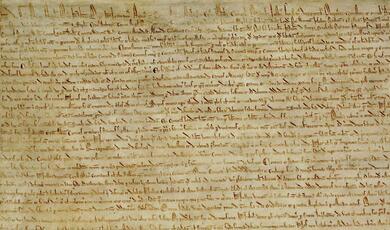Did Sir Walter Scott Invent Scotland?
Share
- Details
- Text
- Audio
- Downloads
- Extra Reading
Walter Scott’s phenomenally popular novels and poems created an image of Scotland as a land of sublime scenery and heroic chivalry. Why is it Scott’s version rather than any of the many other nineteenth-century literary representations of Scotland that has endured in the popular imagination? This lecture will explain why Scott’s romanticised representations of Scotland were such a hit, and how his enduring legacy has helped or hindered Scotland as it seeks to define its place in Britain today.
FULBRIGHT LECTURE
Download Text
17 January 2017
Did Sir Walter Scott Invent Scotland?
Dr Juliet Shields
Walter Scott was called by his early nineteenth-century readers the Magician of the North. His supposed invention of Scotland does indeed seem like an act of magic. Through his poems and novels, Scott created an image of Scotland that is still alive and well today even though very few people read his novels and still fewer his poems. His is a Scotland of sublime Highland landscapes punctuated by dark lochs and splendid castles and peopled by courageous heroes in kilts fighting battles we already know they will lose. It is a Scotland that flourishes on shortbread tins in the shops on Edinburgh’s Royal Mile and in Diana Gabaldon’s Outlander series. The belief that Scott was the inventor of this Scotland has a long history. In August of 1871, on the centenary of Scott’s birth, Blackwood’s Edinburgh Magazine featured an essay celebrating his achievements. It declares that only
“a hundred years ago there was no Scott known in Scotland. No Scott! No genius of the mountains, shedding colour and light upon their mighty slopes; no herald of past glory, sounding his clarion out of the heart of the ancient ages; no kindly, soft-beaming light of affectionate insight brightening the Lowland cottages....No Highland emigration could depopulate those dearest hills and glens as they are depopulated by this mere imagination. A hundred years ago they were bare and naked—nay, they were not, except to here and there a wandering, hasty passenger.” (230-1)
The writer of this panegyric, a woman named Margaret Oliphant to whom I’ll return later, suggests that without Scott, Scotland would be literally unimaginable—a void—to most Britons.
As Oliphant recognized, nations are not merely political entities. They are also, in the words of Benedict Anderson, “imagined communities,” the members of which are bound together by the shared stories they tell about themselves. Literature thus plays a central part in creating the amorphous collection of beliefs, values, and traditions that we call national identity. The novel, which emerged in Europe in the eighteenth century and came into its own in the nineteenth, has been particularly important in the formation of national identities because it has been one of the most accessible and affordable forms of literature. Oliphant acknowledges the novel’s significance in creating a Scottish identity when she points out that not only was there no Walter Scott in Scotland a century ago,
“There were no novels; and a hundred years ago, the past history of Scotland was a ground for polemics only—for the contentions of a few historical fanatics, and the investigations of antiquarians—not a glowing and picturesque past in which all the world might rejoice, a region sounding with music and brilliant with colour, as living as our own, and far more captivating in the sheen and brightness of romance than the sober-tinted present.” (230)
According to Oliphant, and many other nineteenth-century readers, then, Walter Scott did indeed invent Scotland—or at least one version of it. The first part of my talk today will investigate in greater detail exactly how he did that. The second part will survey the versions of Scotland depicted by a few other nineteenth century novelists. I’ll ask why these versions lost out historically, and suggest why it might be important to recover them.
1. Scott’s Great Invention
Walter Scott first made his mark in the literary world not as a writer, but as an antiquarian. In 1802 he published Minstrelsy of the Scottish Border, a collection of ballads he gathered during his rides through the borders as Sheriff deputy for Selkirk. Scott presented this hugely popular collection of songs and ballads to the reading public as a repository of tradition, but already his creative impulse was at work. He “improved” upon his raw materials by changing words, inserting new stanzas, mending rhymes and rhythms, and fusing various versions of songs. Although we might look askance at these practices as damaging the authenticity of his materials, we should also remember that ballads are malleable and often exist in multiple versions. In a sense, Scott was only doing what had happened naturally over time when songs and stories were passed from one person to another and words were set to new tunes or narratives adapted to suit different circumstances.
The success of the Minstrelsy inspired Scott’s first major narrative poem, a tale of sixteenth-century Border rivalry interwoven with legends of the wizard Michael Scott and his goblin servant Gilpin Horner. The Lay of the Last Minstrel, published in 1805, enjoyed unprecedented sales for a work of poetry and brought Scott instant fame. The description of the moonlit Melrose Abbey (Canto II, stanza 1) brought a stream of sightseers to its ruins and was the first instance of Scott's immense impact on Scotland’s tourist industry. The Lay's success determined the line that Scott's work was to take for the next nine years as he produced a succession of major narrative poems. Marmion (1808) described Scotland's defeat at Flodden Field, and The Lady of the Lake (1810) dramatized the sixteenth-century struggle between King James V and the powerful clan Douglas. With 25,000 copies sold in eight months, The Lady of the Lake broke all records for the sale of poetry and created a tourist vogue for Loch Katrine and the Trossachs.
The Lady of the Lake was unusual among Scott’s poems in that reviewers were as enthusiastic about it as the general reading public. Scott wrote to entertain. He sought to provide his readers with a gripping tale in verse rather than to inquire into the depths of the human psyche, like Samuel Taylor Coleridge, or to reflect upon the splendors of the natural world, like William Wordsworth. Thus Thomas Carlyle would lament after Scott’s death that “in this nineteenth century, our highest literary man, who immeasurably beyond all others commanded the world’s ear, had, as it were, no message whatever to deliver to the world; wished not the world to elevate itself, to amend itself, to do this or to do that, except simply pay him for the books he kept writing.”[1] But if critics like Carlyle missed food for thought in Scott’s poems, the reading public ate them up, and they far outsold Wordsworth and Coleridge’s Lyrical Ballads. It was only when Lord Byron took to writing long narrative poems with Childe Harold’s Pilgrimage (1812-18) that Scott saw sales of his poetry begin to decline. This inspired him to try his hand at a new form, one that lent itself to his narrative impulse—the novel.
This was a risky move on Scott’s part. Whereas poetry had long been considered high art, the novel, as a comparative newcomer on the literary scene, was regarded as little more than popular trash, suitable reading matter only for women and children. Scott chose to publish his first novel, Waverley; or ‘tis Sixty Years Since, anonymously in order to protect his literary and professional reputation, as writing fiction would not have been regarded as an appropriate pastime for a Principal Law Clerk at the Court of Session, a post that signified legal erudition and authority. The manuscript was copied out by Scott’s printer James Ballantyne so that even the men who composed the type on the printing press didn’t know the author’s identity. Only those closest to Scott were let into the secret of his authorship, though many readers came to suspect it. Scott's novels would continue to be issued anonymously or pseudonymously with several different publishing houses until 1827 when Scott admitted his authorship at a public dinner. The mystery surrounding the authorship of the Waverley novels undoubtedly contributed to their popularity and to their seeming authenticity, as Scott, in telling his stories, posed as a range of quirky but knowledgeable figures, such as the parish-clerk of Gandercleugh Jedediah Cleishbotham, whose occupation made him a repository of stories.
Following the publication of Waverley in 1814, Scott wrote during a five-year period a further eight novels set in seventeenth- or eighteenth-century Scotland. It is through these works that Scott can be said to have invented Scotland. To understand just how the Waverley novels did this, I’m going to return for a moment to the essay by Margaret Oliphant with which I began. She explains that before the publication of the Waverley novels, “the past history of Scotland was a ground for polemics only—for the contentions of a few historical fanatics, and the investigations of antiquarians.” Scott’s novels took as their subject some of the most contentious moments of Scottish history—the 1715 and 1745 Jacobite rebellions; the transformation of James VI of Scotland into James I of Britain at the Union of Crowns; and the Covenanters resistance to the Stuart monarchy’s erastianism. Yet rather than stirring up these conflicts, as Oliphant’s historical fanatics might, Scott laid them to rest, in part by transforming political into cultural differences. Scott remarks at the end of Waverley, “There is no European nation which, within the course of half a century, or little more, has undergone so complete a change as this kingdom of Scotland.” Attributing this change to the suppression of the Jacobite Rebellion of 1745, the event that Waverley describes, he fondly recalls “those who in my younger time, were facetiously called ‘folks of the old leaven,’ who still cherished a lingering, though hopeless, attachment to the house of Stuart. This race has almost entirely vanished from the land, and with it, doubtless, much absurd political prejudice—but also many living examples of singular and disinterested attachment to the principles of loyalty which they received from their fathers, and of old Scottish faith, hospitality, worth, and honour.” He goes on to explain that he wrote Waverley “for the purpose of preserving some idea of the ancient manners of which I have witnessed the almost total extinction. I have embodied in imaginary scenes, and ascribed to fictitious characters a part of the incidents which I then received from those who were actors in them.”[2] Scott represented his aim in Waverley as very similar to his project in The Minstrelsy of the Scottish Border, to collect and preserve in print traditions that would otherwise be lost.
Moreover, he sought to reconcile this carefully preserved Scottish past with a British present. Waverley strikes a judicious balance between acknowledging the virtues of the past—the loyalty, courage, and honour embodied in Fergus MacIvor and his Highland clan—while also celebrating the progress that had led to a more enlightened present in which law has replaced violence, and reason has overcome passion. The Waverley novels differentiated Scotland in cultural terms from England, attributing to Scots virtues and traditions they could take pride in without threatening the political unity that had existed, when Scott wrote, for little more than a century.
Scott’s novels are not known for their engaging love stories, but he carefully intertwined the marriage plot with his account of historical events to emphasize British unity in symbolic terms. Waverley again provides an instructive example. Its hero, Edward Waverley, is a young Englishman whose ideals have been shaped by a lonely childhood spent reading tales of chivalry and romance in the dusty library at his uncle’s estate of Waverley Honour. In 1745, when his father obtains him a commission in the army, Waverley is sent to Scotland. During a period of military leave, Waverley visits his uncle’s friend, the Baron Bradwardine, whose estate, Tully-Veolan, is situated near Perth, where the Lowlands meet the Highlands. Although Waverley enjoys the company of the Baron’s lovely daughter, Rose, his desire for adventure leads him further north to Glennaquoich, home to the young chieftain Fergus MacIvor, the living embodiment of all of Waverley’s ideals of heroism. Waverley’s admiration for Fergus is surpassed only by his adoration of Fergus’s sister Flora, who enchants him with her harp-playing and impresses him with her intense devotion to the Jacobite cause. Fergus and Flora win Waverley to their side by appealing to his romantic sensibilities, even though reason tells him that Charles Edward Stuart's attempt to capture the British throne is doomed to failure. After the motley gang of Highlanders is defeated by the King’s army, the vivid attractions of Flora’s zeal eventually give way to the more sedate charms of the politically neutral Rose Bradwardine, who twice rescues the hapless Waverley from dangerous or compromising situations. Waverley and Rose share a desire for domestic tranquility that is at odds with the drama of the Jacobite uprising, and when they marry, they retreat to the now war-ravaged estate of Tully-Veolan. The marriage of the English Waverley and the Scottish Rose has been interpreted as a symbol of Anglo-Scottish Union. However, it’s important to note that this British unity is predicated on the defeat of the Jacobite cause and arguably excludes the Scottish Highlands. By the novel’s end, Fergus has been executed, Flora has taken refuge in a French convent, and those Highlanders that have survived Culloden are left without a chief, the ragged remnants of a once glorious feudal society.
While celebrating the courage and loyalty engendered by this feudal society, Waverley and its successors encouraged readers to regard the Highlands as the site of history. To cross the Highland line was to go back in time, and tourists flocked to Scotland in the hopes of seeing primitive ways of life before they disappeared. As Scott depicted them, the Highlands seemed to offer an escape from the socio-economic problems and environmental blight created by nineteenth-century urbanization and industrialization. There flourished the primitive virtues that the modern world seemed to have destroyed. Queen Victoria, one of Scott’s most celebrated admirers, perpetuated this distorted image of the Highlands in a journal entry that describes a day spent near Loch Lomond in 1869:
“The scene of our drive today is all described in Rob Roy….high, rugged, and green hills…very fine large trees and beautiful pink heather, interspersed with bracken, rocks, and underwood, in the most lovely profusion, and Ben Lomond towering up before us with its noble range….Hardly a creature did we meet, and we passed merely a very few pretty gentleman’s places, or very poor cottages with simple women and barefooted long-haired lassies and children, quiet and unassuming old men and labourers. This solitude, the romance and wild loveliness of everything here, the absence of hotels and beggars, the independent people, who all speak Gaelic here, all make beloved Scotland the proudest, finest country in the world.”[3]
The Gaelic speaking labourers are for the Queen merely a part of the picturesque landscape, as are their “very poor cottages,” and she doesn’t pause to consider the possible causes of their poverty. Similarly, seeing the landscape through the lens of Scott’s works meant that tourists were likely to overlook the real reasons for the Highlands’ “solitude”: landowners’ forced eviction of their tenants, whom they replaced with more profitable inhabitants such as sheep or deer.
While few of Scott’s readers are as well known today as Queen Victoria, it is fair to say that “To have been alive and literate in the nineteenth century was to have been affected in some way by the Waverley novels.”[4] At a time when the average print run of a new novel was 750 copies, each of the Waverley novels commanded an initial print run of between 6,000 and 10,000 copies, and libraries in London reported ordering between 50 and 70 copies of each novel as it appeared in order to meet readers’ demands. [5] The Waverley novels were a commercial success in part because, as studies of their publication history have shown, Scott “achieved an ownership of the whole literary production and distribution process from author to reader, controlling…the editing, the publishing, and the printing of the books, the reviewing in the local literary press, [and] the adaptations for the theatre.”[6] The Magician of the North, as Scott was known, was also an entrepreneur, a curator, and a manufacturer, shaping Scotland’s cultural identity through his involvement in every aspect of the Waverley novels’ production and marketing. New developments in the printing industry and in copyright law also extended the reach of the novels by making it possible to issue them in ever cheaper formats well into the nineteenth century. In the late 1820s, the creation of stereotype plates made it feasible to issue the novels in weekly parts, producing a huge surge in sales and introducing a new class of readers to Walter Scott’s Scotland. By the middle of the nineteenth century, Scott was “by several orders of magnitude, the author whose works had sold the largest number of copies in the English-speaking world.” [7]
Even those aspects of literary culture that Scott could not control directly attest to his influence. The Waverley novels inspired numerous imitations and responses, some of which, like John Galt’s “Tales of the West,” have become respected literary works in their own right. Others, like the spurious Tales of My Landlady, an imitation of Scott’s Tales of My Landlord, are best forgotten. In 1820, a novel called Scotch Novel Reading, by Sarah Green, illustrated the pervasiveness of these Waverley knock-offs through its protagonist Alice, a Londoner who declares herself addicted to reading “Scotch novels” of all kinds. Alice dresses in tartan, attempts to speak Scots, and dreams of visiting Scotland until she meets some real Highlanders—dirty, uncouth, and incomprehensible —who put an end to her obsession.
While these barbaric Highlanders are themselves stereotypes with a long history, Scotch Novel Reading suggests that some of Scott’s contemporaries recognized the Waverley novels’ romanticized representations of Scotland for what they were—that is, romanticized. Yet it was not until the early twentieth century that a new generation of Scott’s readers began to perceive the Waverley novels’ romanticization of Scotland’s past as detrimental to its development in the present. In the wake of the Great War a predominantly socialist group of Scottish writers sought to foster a more robust forward-looking nationalism in place of Scott’s nostalgia. Hugh MacDiarmid, one of the leading figures of this Scottish literary renaissance, found Scott “intolerably prolix, dull, and full of false Romanticism,” concluding that he had “no profound and progressive sense of his country.” MacDiarmid’s close contemporary Edwin Muir bitterly termed Scott and Robert Burns “Sham bards of a sham nation,” and accused Scott of transforming all of Scottish “history into legend, mainly tawdry.”[8] This view of Scott has by no means disappeared. For instance, in 1991 one of the foremost scholars of Scottish literature charged Scott with transforming Scotland into “a museum of history and culture, denuded of the political dynamic which must keep such culture alive and developing.”[9] And in 2002, Mike Watson, the Member of Scottish Parliament for tourism, culture, and sport gave a speech in which he recognized “Scott’s success in putting Scotland on the international map,” but also acknowledged that “the cultural images and identity created by Scott have, in a sense, been too successful.”[10]
I’ve suggested here that this success was in at least partly due to the immense control that Scott exerted during his lifetime over the production and marketing of his novels. If his romanticized version of Scotland has won out over others, it is not simply because of its attractiveness. By blending history with romance, Scott masculinized and raised the status of the novel, a genre that had previously been regarded as lowly because it was primarily written for and by women. This is not to say that Scott put women novelists out of business—after all, Jane Austen, Mary Shelley and Maria Edgeworth were among his contemporaries. But between 1815 and 1825, when the Waverley craze was at its peak, a net rise in the annual publication of novels nation-wide was accompanied by a proportional decline in female authorship; and this pattern was even more marked in Scotland than in England.[11] But the mid nineteenth century saw a resurgence of women writers, and some of them, I’m going to suggest, offered alternatives to the Scotland that Walter Scott had invented. Writers of the early twentieth-century Scottish literary renaissance such as Hugh MacDiarmid and Edwin Muir overlooked these women in their search for a masculine history of Scottish literature that might form the foundations of their socialist nationalism. They focused their vitriol instead on the men who were influenced by Scott—for instance, Robert Louis Stevenson, author of Kidnapped and The Master of Ballantrae, John Buchan, author of The 39 Steps and Greenmantle, and S. R. Crockett and J. M. Barrie, writers of the sentimental sketches known as Kailyard fiction.
The women who wrote between the death of Scott and the Scottish literary renaissance in the 1920s thus fell into a kind of literary historical void from which I hope to recover them. Unlike Sarah Green’s Scotch Novel Reading, these women didn’t attack Scott’s romanticized version of Scotland head-on. Instead, they turned from his sweeping historical vistas to the details of mundane domestic life. This in itself offered readers new perspectives on Scotland. There are few depictions of the everyday in the Waverley novels because they are always set at moments of intense crisis. Frances Jeffrey, a critic for the Edinburgh Review, had in 1817 identified as one of Scott’s weaknesses “his descriptions of virtuous young ladies—and his representations of the ordinary business of…conversation in polished life.”[12] It was precisely in the “ordinary business” of the domestic sphere, the natural habitat of “virtuous young ladies,” that Scott’s female successors located Scottish identity.
Part II: Other Scotlands, Other Futures
I’m now going to turn briefly to some of the versions of Scotland offered by Scottish women novelists, tracing their gradual deflation and diminishment of Scott’s romantic vision over the course of the nineteenth century. The first of my examples, a novel called Clan-Albin, by Christian Isobel Johnstone, was published in 1815, hot on the heels of Waverley. But it is in many ways the antithesis of Waverley, refusing to romanticize either the Highlands or the military conflicts that Scott tends to glamorize. Clan-Albin describes the clearance of the Macalbin clan from their home in Glenalbin, and the ultimate repopulation of the glen through the efforts of its chief, Norman. The wool shortage caused by Britain’s lengthy war with France convinces Colonel Gordon, the current owner of Glenalbin, that replacing his tenants with sheep will increase his profits. Gordon, a Lowlander, has purchased the estate through a legal sleight of hand, after the Macalbins’ participation in the Jacobite rebellion led to its forfeiture; and Johnstone implies that Gordon doesn’t understand or value the ties of loyalty and obligation that have long united landowners and tenants in the Highlands. At the novel’s end, Norman, the rightful chief, triumphantly redeems his family’s estate. But the Macalbin clan is now happy in their new home in Canada, where they have re-established the ways of life they enjoyed in the Highlands. So Norman instead opens the glen to Highlanders from other clans who have been forced from their homes and who don’t wish to emigrate.
Clan-Albin’s ending is obviously fantastic wish-fulfillment, and it seems a far cry from the everyday experiences on which, according to my argument, women writers tended to focus. Yet for Johnstone, one of the major evils of the clearances is that they disrupt a kind of timeless everyday—the traditional ways of Highland life that the novel describes in lovingly ethnographic detail, from the preparation of meals to the education of children. Clan-Albin effectively reverses the foreground and background of Waverley, making domestic life the focus against which political events occur. By representing contemporary—that is, early nineteenth-century--everyday life in the Highlands, Johnstone showed her Lowland and English readers that Highlanders really weren’t much different from other Britons. And in showing that the Highlands, far from being frozen in time, were affected by the military and economic agenda of a government situated in metropolitan England, she hoped to incite readers’ indignation against the landowners who forcibly evicted Highland families from their homes.
While the Highlands remained a popular setting for novels throughout the nineteenth century, Scott’s female successors including Margaret Oliphant, Henrietta Keddie, and Annie S. Swan began to turn towards Scotland’s urban industrial landscapes, presenting to their readers new versions of Scottish life. It should not be surprising that these writers set their novels in the slums of Glasgow, the jute factories of Dundee, or the pit towns that sprang up around coal mines near the borders when we consider that English novelists such as Elizabeth Gaskell and Charles Dickens also were exploring the effects of industrialization on the middle and working classes. Yet literary scholars continue to insist that there was no Scottish equivalent to what is known as the “Condition of England” novel—works that, like North and South or Hard Times, examine the conflicts between factory owners and workers, or depict the effects of urban blight on the minds and bodies of city dwellers.[13] Margaret Oliphant’s Harry Muir: A Story of Scottish Life (1852) is just one of several novels that might be designated a “Condition of Scotland” novel. It is set in Port Dundas, an area of Glasgow that in the nineteenth century was home to textile mills, chemical works, glassworks, and iron foundries. Interestingly, in Oliphant’s novel, Port Dundas is primarily the realm of women, who labor in these mills, factories, and foundries. In the streets their “little stout round forms—faces sometimes sallow, but by no means unhealthy—hair dressed with extreme regard to the fashion, and always excellently brushed, and in the finest order—made these passengers, in their coloured woollen petticoats and bright short gowns, a very comely part of the street population.”[14]
The subtitle of Oliphant’s novel, A Story of Scottish Life, would likely have evoked certain expectations in readers only twenty years after Scott’s death. Anticipating a story set in the grandeur of the Highlands and featuring adventure and intrigue, these readers might have been disappointed in passages like the description of the mill girls which could just as easily be set in the streets of Manchester or Liverpool. Yet Oliphant doesn’t lament the homogenization of Britain, as industrialization made one city much like another. Instead, she suggests that distinctive Scottishness is to be found in the details of everyday life. Not only does Oliphant turn from the sublime Highlands to the industrial Lowlands, she also turns from the grand events of history to mundane domesticity, where markers of Scottish cultural identity are to be found. For instance, Oliphant provides a striking depiction of women’s work in a tenement house on the Port Dundas road. On the top floor, Rose and Martha Muir are embroidering cuffs and collars to be attached to factory-made dresses. As they work, their youngest sister Violet recites “page after page of the Bridal of Triermain”—one of Scott’s narrative poems. On the floor beneath them, Aggie Rodgers, who attaches these elaborately embroidered collars and cuffs to the factory-made dresses, “stayed her needle in mid-course while she accompanied the Ro-o-se of A-ah-allandale.” On the stoop outside the ground floor of the tenement, Maggie McGillivray, who, Oliphant tells us, is “employed to clip the loose threads from webs of worked muslin” sings one of Robert Burns’s songs, “The Lea Rig,” “with a gay flourish of her shears accompanying…every verse.”[15] The scene emphasizes the commonality of these women’s lot, despite the differences in station indicated by the type of needlework they do to support themselves and their families. The tenement has become a domestic factory of sorts, contributing to the textile industries for which Glasgow and Paisley were renowned in the nineteenth century. There is no romance in the women’s unremitting toil, but they find it instead in the stories and songs of courtship that accompany their work and that mark the scene as Scottish.
Oliphant’s description of Glasgow women’s work in Harry Muir is a far cry from the Battle of Bothwell Brig in Scott’s Old Mortality, or the cattle raids in Rob Roy, both in its urban setting and in the scale of the action. My final example of an alternative to Scott’s Scotland, Mary Findlater’s The Rose of Joy (1903), offers an even greater diminution of the Waverley novels’ grandeur while returning us to a rural setting. Mary Findlater and her sister Jane, with whom she co-authored several novels, explored in her fiction the very limited opportunities that rural Scotland could offer even the most resourceful of women who wanted something more than marriage and motherhood. Much as Oliphant offered Scottish alternatives to the “Condition of England” novel, the Findlater sisters’ concerns had an English counterpart in the so-called “New Woman” novels by Sarah Grand and Mona Caird, which challenged the dominant belief that women’s proper place is in the home. Susan, the protagonist of The Rose of Joy, lives in the tiny village of Burrie Bush, “a spot forlorn, forgotten, far away, with no past history beyond the dulled recollections of its oldest crone, where all that was modern was its vulgarity.”[16] In this village without a past or a future, Susan’s life “followed only the ordinary course of too many women’s lives”--a course of relentless domestic drudgery. She struggles to care for her numerous younger siblings and her helpless widowed mother until she accepts her cousin Dally’s proposal of marriage simply because she cannot bear to “just live on at home.”[17]
But Susan has an artist’s eye, and although she has “scarcely the commonest comforts of life in other ways,” Findlater informs us, she can make “a meal off the colour of the sea.”[18] Whereas Dally, who finds Burrie Bush and its environs intolerably dull, turns to unsavory sources of pleasure that eventually destroy their marriage, Susan draws, filling notebooks with “buds, leaves, the heads of marsh rushes, a blue beetle, a snail-shell with its black whorl design, butterflies, a twig with the purple coming of spring, sometimes a landscape so small that you could have covered it with a penny.”[19] The scale and detail of Susan’s drawings resembles that of Mary Findlater’s writing, as her novel explores a circumscribed world in intricate detail. Theirs is not the sublime Highland scenery portrayed in the paintings of Alexander Naysmith or the novels of Walter Scott; for, as the narrator remarks bluntly, “the sphere of the village is a small one.”[20] But Findlater implies that there’s as much beauty to be enjoyed in a perfectly rendered representation of a beetle as in a panoramic view of the Trossachs. Susan’s world is indeed small compared to the sweeping landscapes through which Edward Waverley moves, but it contains more than enough beauty to satisfy her once she realizes that she can support herself through her artwork. Walter Scott famously wrote in his journal after re-reading Jane Austen’s Pride and Prejudice, “The big bow-wow strain I can do myself like any now going; but the exquisite touch, which renders ordinary commonplace things and characters interesting, from the truth of the description and the sentiment, is denied to me.”[21] Findlater’s Rose of Joy shows readers the beauties of rural Scotland through “ordinary commonplace things,” the anti-thesis of the Waverley novels’ “big bow-wow strain.”
The three novels I’ve mentioned here—Clan-Albin, Harry Muir, and The Rose of Joy—are so different from each other that it seems in many ways odd to lump them together. But they share in common the aim of de-romanticizing and diminishing the grandiose and idealized image of Scotland created in Scott’s Waverley novels. In their own time, the women whose novels I’ve discussed here were well known and respected literary figures. So why are they now virtually unknown? And why have their representations of Scotland fared so poorly over time compared to Scott’s? Possibly, their novels weren’t as good as Scott’s. Possibly, their representations of Scotland weren’t as aesthetically pleasing as Scott’s. But these explanations are too simple. They beg the question of why Scott’s Scotland has remained so appealing for so long, well after his novels ceased to be popular, or even to be read. Judgments about literary value are rarely disinterested or objective, and it has often been the case historically that some literary works “win out” over others for ideological reasons. If representations of grimy industrial Scotland or dull agricultural Scotland weren’t as influential over the long term in shaping readers’ perceptions of the nation, it is not just because they weren’t as attractive, but also because they weren’t as politically useful, either for Scots or for Britain as a whole. The Waverley novels’ romanticized version of Scotland was attractive to Scots because it gave them a cultural identity distinct from England’s—one that transcended differences of class, religion, and political party. It was useful to the continued unity of the British state because it assigned Scotland a valuable contributing role as the bastion of traditional ways of life and unspoiled nature, while legitimating a more civilized and progressive England’s role as governing authority. But as the unity of the British state becomes increasingly questionable, in the wake of devolution and with the possibility of a second referendum on Scottish independence, it is arguably useful to turn to these long-neglected alternative versions of Scotland, versions that are less grandiose, but perhaps more serviceable for their lack of grandeur. If nations are indeed imagined communities, then surely it is wise to exercise our imaginations broadly. The more versions of its history a nation has, the greater are its possibilities in shaping its future.
© Dr Juliet Shields, 2017
[3] Victoria in the Highlands, ed. David Duff (London: Frederick Muller, 1968), pp. 246-7.
[4] John Henry Raleigh, “What Scott Meant to the Victorians,” Victorian Studies 7 (1963), p. 10.
[6] St. Clair, Reading Nation, p. 170.
[7] St. Clair, Reading Nation, pp.418-19.
[12] Review of Tales of My Landlord, Edinburgh Review 28 (1817), p. 197.
[14] Margaret Oliphant, Harry Muir; A Story of Scottish Life (New York: Appleton, 1852), p. 41.
[15] All quotations in this paragraph from Oliphant, Harry Muir, p. 43.
[16] Mary Findlater, The Rose of Joy (London: Methuen, 1903), p. 9.
[17] Findlater, Rose of Joy, pp. 46. 130.
[18] Findlater, Rose of Joy, pp 172, 96.
[19] Findlater, Rose of Joy, p. 51.
[20] Findlater, Rose of Joy, p. 23.
Part of:
This event was on Tue, 17 Jan 2017
Support Gresham
Gresham College has offered an outstanding education to the public free of charge for over 400 years. Today, Gresham College plays an important role in fostering a love of learning and a greater understanding of ourselves and the world around us. Your donation will help to widen our reach and to broaden our audience, allowing more people to benefit from a high-quality education from some of the brightest minds.


 Login
Login







